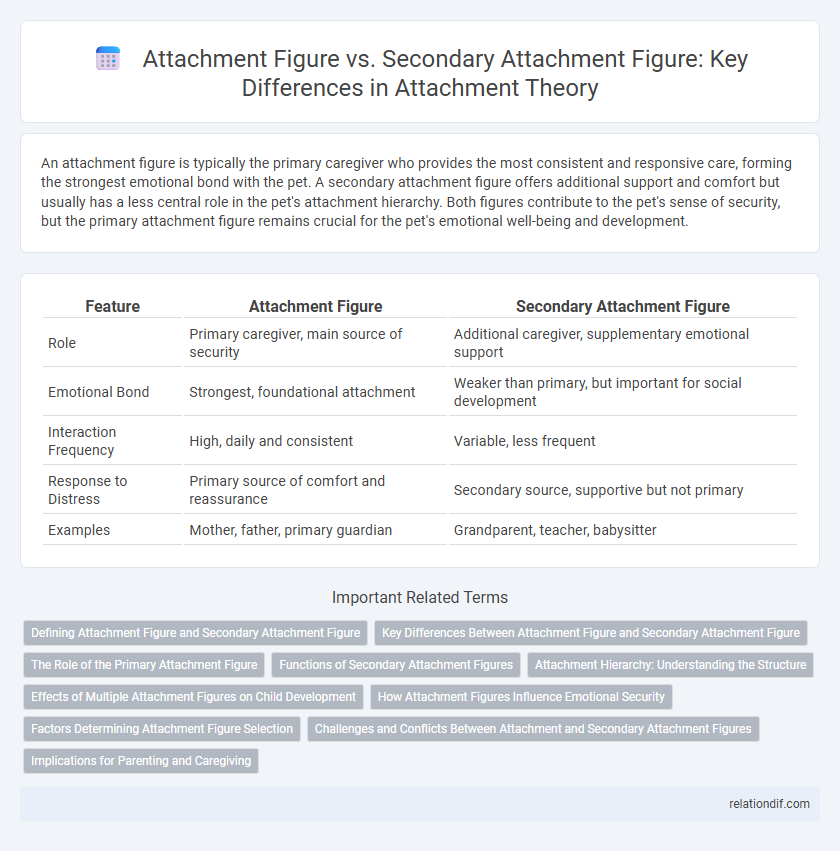An attachment figure is typically the primary caregiver who provides the most consistent and responsive care, forming the strongest emotional bond with the pet. A secondary attachment figure offers additional support and comfort but usually has a less central role in the pet's attachment hierarchy. Both figures contribute to the pet's sense of security, but the primary attachment figure remains crucial for the pet's emotional well-being and development.
Table of Comparison
| Feature | Attachment Figure | Secondary Attachment Figure |
|---|---|---|
| Role | Primary caregiver, main source of security | Additional caregiver, supplementary emotional support |
| Emotional Bond | Strongest, foundational attachment | Weaker than primary, but important for social development |
| Interaction Frequency | High, daily and consistent | Variable, less frequent |
| Response to Distress | Primary source of comfort and reassurance | Secondary source, supportive but not primary |
| Examples | Mother, father, primary guardian | Grandparent, teacher, babysitter |
Defining Attachment Figure and Secondary Attachment Figure
An attachment figure is a primary caregiver who provides consistent emotional security and nurturance, typically a parent or guardian critical for a child's development. A secondary attachment figure offers supplementary support and comfort, often a teacher, relative, or close family friend who contributes to the child's social and emotional growth. The distinction lies in the primary attachment figure's role in ensuring survival and foundational trust, while secondary figures reinforce attachment behaviors and broaden social networks.
Key Differences Between Attachment Figure and Secondary Attachment Figure
Attachment figures primarily provide emotional security and are central to a child's development, often being the mother or primary caregiver. Secondary attachment figures offer supplemental support, promoting social and cognitive growth without the intense emotional bond characterizing the primary attachment. These key differences highlight how attachment figures form the foundation of trust, while secondary figures enhance broader social experiences.
The Role of the Primary Attachment Figure
The primary attachment figure plays a crucial role in a child's emotional development by providing consistent comfort, security, and responsiveness, essential for forming a secure attachment bond. Unlike secondary attachment figures who offer supplementary support, the primary figure establishes the foundational sense of trust and safety necessary for healthy social and emotional growth. This central relationship influences the child's future attachment patterns and overall psychological well-being.
Functions of Secondary Attachment Figures
Secondary attachment figures provide supplementary emotional support, social interaction, and exploration encouragement alongside the primary attachment figure. They contribute to the child's sense of security by offering alternative sources of comfort, protection, and guidance in different social contexts. These figures play a critical role in broadening the child's social network and fostering adaptive social development.
Attachment Hierarchy: Understanding the Structure
Attachment hierarchy refers to the structured ranking of attachment figures based on the security and comfort they provide to an individual, typically prioritizing the primary attachment figure such as a parent or caregiver. Secondary attachment figures, like teachers or close relatives, hold supportive roles that become crucial during the absence or unavailability of the primary figure. Understanding this attachment hierarchy is essential for comprehending how individuals seek comfort and maintain relational bonds across different social contexts.
Effects of Multiple Attachment Figures on Child Development
Multiple attachment figures, including primary and secondary caregivers, provide diverse emotional support essential for secure child development. Primary attachment figures typically offer consistent responsiveness and protection, fostering a stable base for exploring the environment, while secondary attachment figures contribute supplementary social and cognitive stimulation. The presence of multiple attachment figures correlates with enhanced emotional regulation, social competence, and resilience in children, emphasizing the benefits of a broad support network during early developmental stages.
How Attachment Figures Influence Emotional Security
Attachment figures, primarily caregivers, provide a secure base that fosters emotional regulation and resilience in children, directly influencing their sense of safety and trust. Secondary attachment figures supplement this security by offering additional emotional support and social learning opportunities, enhancing a child's adaptability across diverse social contexts. The quality and consistency of interactions with these figures critically shape the child's emotional security and long-term relational patterns.
Factors Determining Attachment Figure Selection
Attachment figure selection is influenced by consistent responsiveness, emotional availability, and the reliability of caregivers in meeting the child's needs. Primary attachment figures often provide the most secure base due to frequent interactions and sensitive caregiving, while secondary attachment figures contribute supplementary emotional support and socialization experiences. Factors such as proximity, caregiving quality, and the child's temperament play critical roles in distinguishing between primary and secondary attachment figures.
Challenges and Conflicts Between Attachment and Secondary Attachment Figures
Challenges between attachment figures and secondary attachment figures often stem from inconsistent caregiving styles, leading to confusion and insecurity in the child's emotional development. Conflicts arise when secondary attachment figures offer differing responses to the child's needs compared to the primary attachment figure, potentially disrupting trust and attachment security. These discrepancies can hinder the child's ability to form stable and coherent attachment models essential for healthy social and emotional growth.
Implications for Parenting and Caregiving
Primary attachment figures, typically parents, provide the crucial emotional security and consistent caregiving essential for healthy child development. Secondary attachment figures, such as relatives or caregivers, offer supplementary support that reinforces social and emotional skills but do not substitute the primary bond's influence on attachment styles. Understanding the distinct roles of these figures informs parenting strategies by emphasizing stable, responsive interactions from primary caregivers while encouraging diverse social experiences through secondary attachments.
Attachment Figure vs Secondary Attachment Figure Infographic

 relationdif.com
relationdif.com